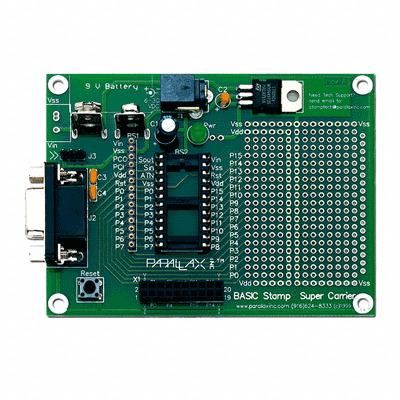How to pick out the right microcontroller for your next project
BY MELISSA SUE SORRELLS GALLEY
We see it all the time on Digi-Key’s TechXchange forum : beginning electrical engineering enthusiasts looking to select their first microcontroller . With more than 36,000 microcontrollers to choose from on Digi-Key alone, getting started can be a bit, well, daunting.
To start with the basics, a microcontroller is a small computer: a CPU, memory and programmable input and output peripherals all wrapped up in a tiny package. You can buy these simple, usually tiny devices as is, but many entry-level hobbyists choose to work with a development board, which is built onto a circuit board and ready to use out of the box. They’re an inexpensive and immediately-gratifying entrance into electrical engineering.

A BASIC Stamp Super Carrier Microcontroller Board (via: digikey.com)
But which microcontroller is right for you? Here are three things to consider:
Community:
Support and documentation is a huge consideration. Many microcontrollers are open source and have an active online community of supporters. For example, there are many sample projects for Arduino, which are perfect for those just learning. When you’re selecting a microcontroller board, make sure that the company offers plenty of technical support and that you’ll find friendly folks willing to help you if you run into a wall.
Language:
If you can’t talk to your microprocessor, then you’re in for a struggle. Make sure the microcontroller board you select speaks your language. Arduino relies on C or C++, while Stamp is programmed using BASIC. PIC microcontrollers can be programmed in C, Assembly, or BASIC. You also need to be sure that your microcontroller can talk to your computer: Stamp requires a Windows-based system, while Arduino and PIC can speak with Mac and Linux platforms as well as Windows.
Cost:
There are microcontroller boards available at many different price points, but they tend to be reasonably priced, ranging from as low as $4 with Texas Instrument’s Launchpad to more than $100 for products like BeagleBoard. Find a company with a range of products within your budget so that when you’re ready for a more advanced project, you’ll already be familiar with a family of microcontrollers that you can afford.
Of course, you could sidestep the entire selection process by building your own microcontroller — it’s a cheaper alternative and a great opportunity to learn valuable basic skills. But for those looking for a quick, out-of-the-box microcontroller for a project or just to learn about how basic electronics work, pre-built units are the best way to go.
What do you look for in a microcontroller? Post your ideas and questions on the TechXchange forum . ■
Advertisement
Learn more about Electronic Products Magazine





